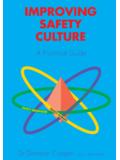Transcription of VEHICLE FIRES A PRACTICAL APPROACH - k …
1 VEHICLE FIRES A PRACTICAL APPROACH by Mike Higgins - K-Chem Labs - Westford, Massachusetts Determining the origin and cause of a VEHICLE fire is indeed a formidable task. Before one attempts to determine the "how s" and "why s" of a VEHICLE fire you must know and understand the makeup of the materials that the VEHICLE is constructed from. Knowing the ignition temperatures, flash points, melting points and flammability of the various materials is a must in making these determinations. Use reference guides such as NFPA 921 Guide for fire & Explosion Investigations. It is also very important to know how recently the VEHICLE has been operated. It is much easier for FIRES to accidentally start in a hot engine area than a cold and a fire will burn and expand quicker in a hot engine compartment.
2 Unlike dwelling FIRES , VEHICLE FIRES burn similar to a fire in a barrel or small incinerator. The major damage occurs in a short period and the fire becomes all encompassing. Normally, within fifteen minutes, major destruction has occurred and in many cases, the evidence that would indicate what caused the fire to start will be destroyed. There are two major groups that VEHICLE FIRES come under, Intentional and Accidental. Intentional FIRES Insurance fraud is one of the major reasons for VEHICLE FIRES and in many cases; the VEHICLE has been reported stolen. To make this a successful endeavor the owner must make this whole scenario appear as though it was performed by a thief; therefore, the owner must think like a thief. He or she has to make sure everything is done to make the VEHICLE look as though it was stolen when it is found by the police or fire department.
3 The ignition system must be defeated in such a way that someone could start and/or steer the VEHICLE . If they don't defeat the ignition system they must be able to show that someone could have a copy of their key, use a special key that will operate their VEHICLE or their lock was picked. This is an area where the investigator must use a lot of caution because of the many lock-picking and by-passing devices that are available on the market If the VEHICLE is equipped with an alarm or anti-theft system, this also must be defeated. Many of these devices like Chapman locks and kill switches can deter the amateurs thief but knowledgeable thieves can defeat most of these systems in a short period. In most of these systems, the thief goes under the hood and simply pulls the alarm or shorting wire off.
4 With the newer vehicles the transponders are very popular and offer a greater challenge to thieves. Vehicles are stolen for various reasons some of which are profit, joy rides or to be used in a crime. The owner wanting to follow this assumption, in many cases, will remove something of value to make the theft scenario look good. The problem at this point is that the owner, in most cases, does not know how to do all the above. To cover up for his lack of knowledge, he will burn the VEHICLE hoping to cover his mistakes. Vehicles that are stolen for joy rides and to commit crimes are burned in many cases to cover up fingerprints or any evidence that may have been left behind. If the engine is in very bad condition or possibly to the point of seizing, the owner will sometimes start the fire in the engine compartment as well as the interior.
5 If the insured performed all of the above procedures properly then your job of proving fraud will be near impossible. Thankfully, in many of these cases, they do not do all that they should properly. In all of these cases a thorough investigation of the VEHICLE and the facts surrounding the theft must be performed. Determining the origin and cause of these FIRES is usually straight forward because no one is trying to hide the fact that the VEHICLE has been purposely set on fire . Note; Do not do these investigations lightly. If a police or fire agency is going to charge the owner with attempting to defraud the insurance company and burning of a motor VEHICLE , a good fire investigation must be done. If the fire is put out in a reasonable period, you will have a good chance of making the exact determination and finding an accelerant if one was used.
6 In many of these FIRES the VEHICLE is taken to a remote location where it is near impossible to get at the VEHICLE readily thus allowing it to burn near complete. As impossible as it may seem, we have had successful investigation with these so-called 1 "Crispy Critters". In the debris, we have found keys and other items that indicate the VEHICLE was not stolen. Other types of intentional FIRES are; revenge, to cover up a crime and destroy evidence. Investigating a revenge fire is difficult because no one seems to know the reason why or motive the VEHICLE was burned unless a message of some type was conveyed to the victim. In many cases, these FIRES are left undetermined if they are burned out, credited to vandalism or are very obvious due to the hurried manner the fire was set.
7 These FIRES occur in the vicinity of where the victim works or lives. Rarely will you see a VEHICLE stolen for the purpose of revenge. This would expose the perpetrator to his greatest fear, which is of being caught. FIRES to cover up a crime or destroy evidence are not always obvious because you are dealing with professional thieves that know how to steal vehicles. In many cases, these vehicles are fairly new and fast. These vehicles will be found with various levels of ignition damage and nothing will be stolen from them. If the insurance company or police agency investigator does not know that the VEHICLE was stolen for use in a crime, they may suspect that the owner is involved because nothing was stolen from the VEHICLE . This is where proper investigative techniques must be used to avoid accusing an innocent person of a crime or denying their insurance claim.
8 Improperly factory installed battery cable on the solenoid caused five new vehicles to burn. Accidental FIRES 2 This is where your knowledge of the particular VEHICLE is very important. Before attempting to examine the VEHICLE , check on line to the various consumer and government agencies to see if there are recalls or historical data to assist you. The majority of accidental FIRES occur in the engine compartment. This is true for automobiles, trucks and heavy equipment. Prior knowledge of how the components are laid out and how dense their arrangement is will help you to understand how rapid the fire spreads. The engine compartments of modern vehicles have many plastic components that once ignited will quickly spread the fire . In some inexpensive or older vehicles, the population of components in the engine is sparse and there is less plastic used.
9 In these vehicles fire does not spread as rapidly therefore burns for a longer period or it has a better chance of burning itself out. The origin of the fire in the engine is sometime quite difficult because of the amount of flammable items and how easy the fire transmits between them. For example, assume that an electrical wire in a harness shorted in such a way that it became very hot. This would cause the vinyl coating on the wire, and those surrounding it, to melt and then ignite. The harness will now act like a wick carrying the fire to a location where other flammable items are, thus causing them to ignite. Now assume the secondary fire burns very intense before the fire is put out. For example: If the fire burns in the area of the master cylinder or hydraulic lines in heavy equipment, the fluid will ignite resulting in an intense area of burning.
10 The appearance of this second burn will make it look like the origin. This will also mislead investigators to thinking that the short was caused by second fire . Like in most FIRES , the greatest area of burning is not necessarily the area of origin. What came first, the chicken or the egg? This is a common dilemma in VEHICLE fire determination. fire along the door of this VEHICLE was caused by poor workmanship while installing a 12volt line to a lantern charger VEHICLE FIRES are caused by defective or worn components, poor workmanship, age or normal deterioration and lack of proper maintenance. Before attempting to examine a burned VEHICLE , find out its history. When was the last time the VEHICLE was driven? How well did it run? When is the last time the VEHICLE was serviced?



